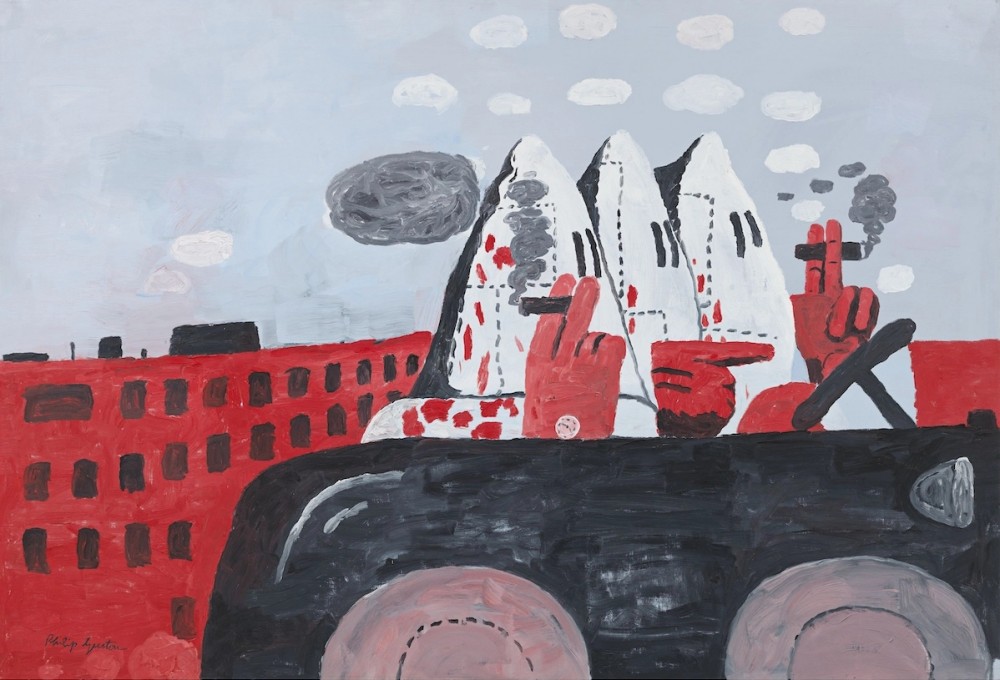JUSTIFIED OFFENSE
2021
63) Walker, Kara. “kara_walker_official” Instagram. March 23, 2017.
64) “Open Letter: On Philip Guston Now.” The Brooklyn Rail, September 30, 2020.
BY 开伦
63) Walker, Kara. “kara_walker_official” Instagram. March 23, 2017.
64) “Open Letter: On Philip Guston Now.” The Brooklyn Rail, September 30, 2020.
BY 开伦
Philip Guston - Riding Around, 1969

As stated, the value of offense lies in its ability to call attention to and generate discourse around the line that has been crossed. But this value is a morally neutral one. Offense does not inherently direct this discourse towards positive outcomes any more than it does towards negative ones. Offense can call attention to injustice, just as it can trivialize serious issues and make people feel mocked, subjugated, and hurt. Given these potential consequences, the former does not always justify the latter.
As these case studies hopefully demonstrate, applying strictly deontological, consequentialist, or aesthetic imperatives to the concept of offense can produce harmful results, damaging the critical relationship between artist and viewer, institution and public. For this reason, applying these imperatives categorically when determining if an offense is justified is not only misguided, but potentially censorial. In order to bring a greater degree of nuance to such a consideration, all three approaches are needed in varying degrees. In that sense, such a justification could be derived from a consideration of the intentions of the artist and the exhibiting institution, the work itself and whether it fulfills these intentions, and finally, the outcomes that resulted from the public’s encounter with the work, both positive and negative.
These proposed criteria, however, are not exclusive. There are undoubtedly many other considerations to take into account when justifying offense, but they lie beyond the scope of this essay. These criteria also do not guarantee positive outcomes. Just as the sensibilities of what is offensive shift across time and cultures, so too do the justifications of the violation of these sensibilities. But in the moment in which this essay is written, in the context of contributing to the discourse concerning western contemporary art, these criteria are put forth in an effort to improve the conversation.
In terms of the current conversation, this essay makes the case that one of the first concepts to which this criteria could be applied is that of identity and how it maps onto art practice today. But already, improvements are starting to manifest themselves. Artists have begun to push back against contemporary sensibilities concerning offense and identity, such as when the artist Kara Walker, who is black, wrote in response to the Open Casket controversy that she (Walker) is “...more than just her trauma,” and that artists should have the right to comment on issues outside of their personal experience.63 Likewise, as was stated in the examination of How to be a Successful Black Artist, artists like Musson are starting to call out the absurdity and double-standards that such sensibilities have created to a largely positive reception.
Most recently, an open letter that has attracted thousands of signatures from artists, curators, and critics was published in response to the directors of four art institutions who decided to delay a retrospective of the deceased Philip Guston.64 Guston, who was white, depicted Klu Klux Klan members in cartoonish abstraction, which was why the decision was made to delay the exhibition as an acknowledgment of the current political climate. The letter makes the case that this acknowledgment was largely superfluous, and that superfluous gestures do not justify censorship.
Ultimately, this essay is meant to be an argument for freedom of expression. The concept of offense, or more specifically, the misapplication of this concept, must be revaluated if this freedom is to be maintained. Hopefully, the examination of these artworks, artists, and resulting reactions can meaningfully contribute to that revaluation.